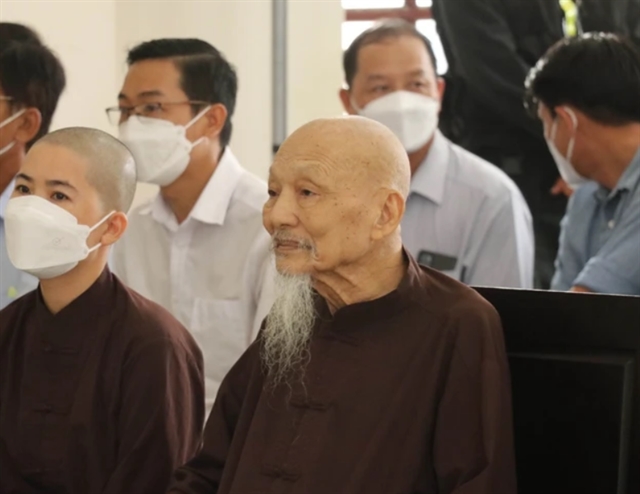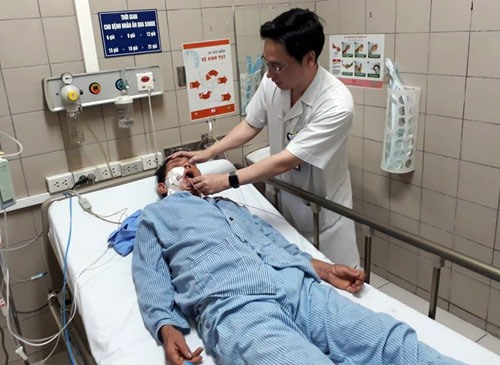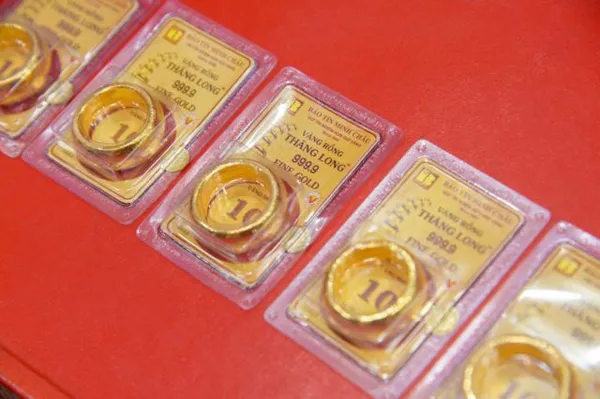 Society
Society

A spate of wild mushroom poisonings in the mountainous provinces has alarmed doctors who fear locals are disregarding their warnings that the only way to prevent poisoning is to avoid eating wild mushrooms entirely.
 |
| A doctor examines patient Sùng Diu Hồng, the only survivor of a wild mushroom poisoning case in Hà Giang Province.—Photo danviet.vn |
HÀ NỘI – A spate of wild mushroom poisonings in the mountainous provinces has alarmed doctors who fear locals are disregarding their warnings that the only way to prevent poisoning is to avoid eating wild mushrooms entirely.
Wild mushrooms sprout in the springtime in mountainous areas, leading people who live there to increase mushroom consumption. In some cases entire families have died after eating wild mushrooms.
On April 4, the Hà Nội’s
A patient named Sùng Diu Hồng, born in 1966, of Thuận Hóa Commune in Vị Xuyên District, was transferred to the Center for Anti-Poisoning on April 2 in a state of alertness, abdominal pain, skin and mucosa.
Hồng had coagulopathy, elevated liver enzymes and severe liver damage. After two days of treatment, doctors still didn’t dare to predict the disease progression of the patient because toxins had been absorbed into the liver.
On the morning of March 28, Sùng Diu Hồng came to the hill in the back of his house to pick wild mushrooms for the family’s breakfast.
The family of four people including Sùng Diu Hồng, his wife Thào Thị Vản, his daughter-in-law Ly Thi Pà and his son Sùng Văn Hoành all ate mushrooms for breakfast.
At 4 pm the same day, all four people developed headache symptoms, nausea and vomiting food and diarrhea.
At Hà Giang Province’s
Sùng Văn Hoành died on March 31, followed by Thào Thị Vản on April 1 and Ly Thi Pà on April 2. The cause of death was acute liver failure by wild mushroom.
Dr. Nguyễn Tiến Dũng from the Center for Anti-Poisoning said that Sùng described victims eating white, bowl-size mushrooms. Doctor surmised that this was a white poisonous mushroom, containing poisonous amatoxin.
The wild mushroom causes symptoms of poisoning, usually within six to nine hours after eating.
Up to 50 per cent of people who are poisoned by wild mushrooms will die, doctors say. The cost of treatment for mushroom poisoning cases was very high, up to hundreds of millions of đồng per person.
According to Dr Dũng, the victims of wild mushroom-poisoning are often very poor. Wild mushrooms are known to be delicious and sweet, so many people living in areas where they grow find them attractive.
Doctors calling on people not to eat wild mushrooms also encountered opposition from people who say non-poisonous mushrooms are affordable and nutritious, and are unwilling to eliminate them entirely from their diets.
“However, toxic and non-toxic mushrooms are sometimes difficult to identify. Even biologists and mushroom experts must consider them carefully to distinguish between them," Dũng said.
Cooked mushroom still poisonous
Mushroom poisoning has been occurring for many years in ethnic minority areas.
According to the
In Cao Bằng Province, from 2003 to 2009 there were 29 mushroom poisoning cases that sickened 81 people and killed 17 deaths.
In Bắc Kạn Province from 2004 to 2011 there were 28 mushroom poisoning cases, with 94 sickened and 14 deaths.
Addressing the idea that cooking a mushroom will kill all toxins within it, Dr. Nguyễn Trung Nguyên at the Center of Anti-Poisoning affirmed that amatoxin in mushrooms persists regardless of the temperature to which it is heated.
Some people feed a mushroom to an animal such as a dog or chicken to determine if it is poisonous. But many poisonous mushrooms affect victims only after many hours, so this method of identification is ineffective, according to Dr Nguyên.
Wild mushrooms that are eaten by ants may also be poisonous.
Some people believe that if a mushroom is brushed with a silver spoon or coin and the silver does not turn black, the mushroom is safe to eat. This is also a misconception, according to the doctor.
Many mushroom species cause nausea and diarrhea later, but then the sickness stops, leading patients and even doctors to believe the poisoning has stopped, too.
However, according to Dr Nguyên, the patient may continue to develop symptoms, including yellow eyes, jaundice, inability to eat, abdominal pain and fatigue. Gradually the patient will become delirious and enter a coma due to liver failure, experience internal bleeding and finally death.—VNS
Doctors advise that if a person accidentally eats poisonous mushrooms or wild mushrooms and has symptoms of vomiting and diarrhea after an hour or two, the family of the poisoned person should give them between half a litre and a litre of water and stimulate vomiting to eliminate all of the consumed mushroom.
If possible, activated charcoal should be given to the poisoned person. About two grams should be given for every 15kg in weight.
Then the family should immediately take the patient to the nearest hospital for treatment.









